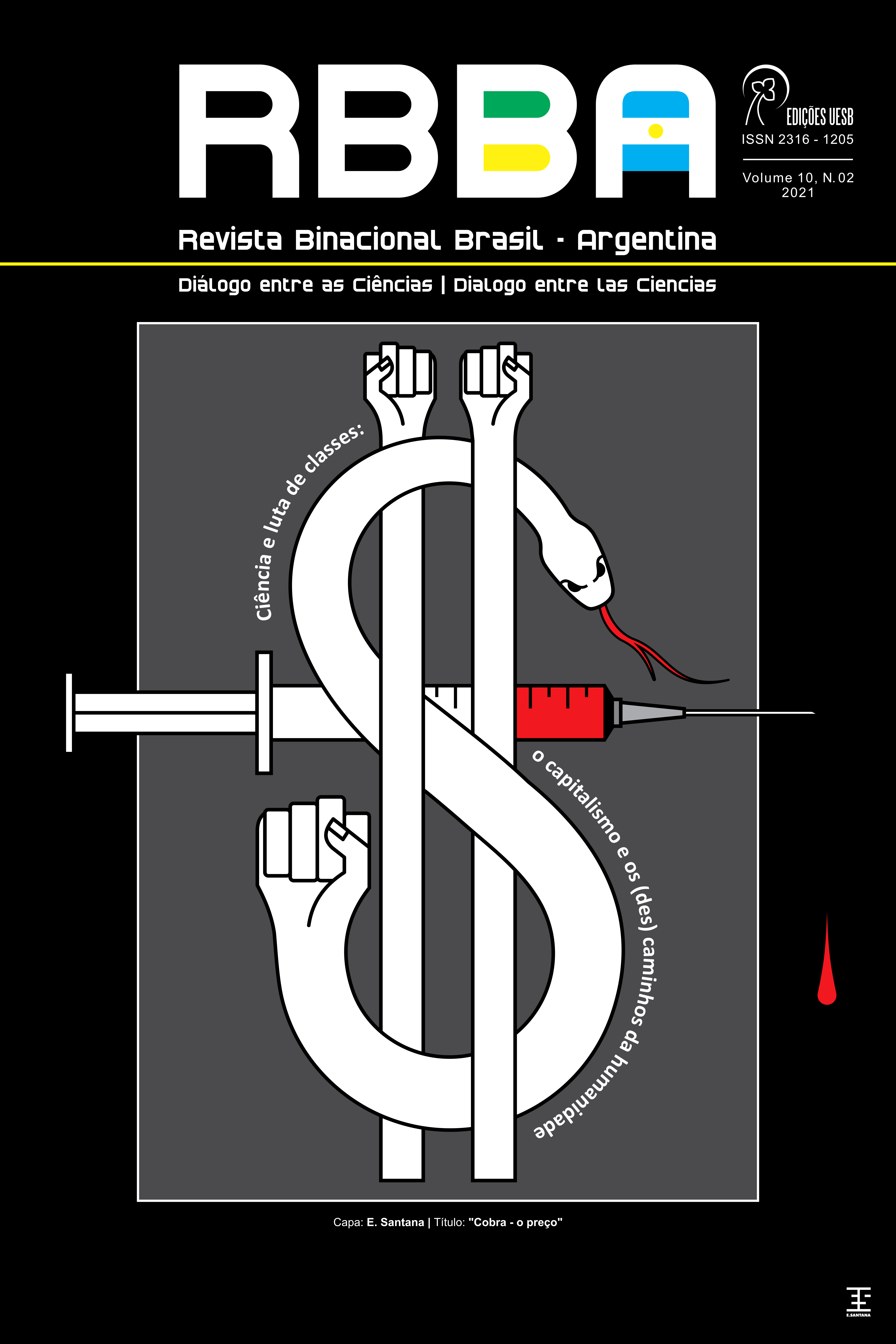THE TEACHING OF BRAHMAGUPTA'S POLYGONS: A CONTRIBUTION OF DIDACTIC ENGINEERING
DOI:
https://doi.org/10.22481/rbba.v10i02.9015Keywords:
History of Mathematics, Hindu Mathematics, BrahmaguptaAbstract
The subject of History of Mathematics aims to discuss the development of Mathematics from studies of ancient civilizations. One such civilization is the Hindu. Despite their notoriety, there are few academic works that propose teaching methodologies focused on the geometry developed by them. Most are poring over the discoveries of Europeans not giving the Hindu people their due credit. In this sense, this manuscript aims to present a Didactic Situation about the Polygons of Brahmagupta, a famous Hindu mathematician, based on the assumptions of the Didactic Situation Theory, with the support of Geogebra software as an auxiliary resource for the teacher and students. As a research methodology, we adopted Didactic Engineering, in its two beginnings. We conclude, in the preliminary analysis, that there are no records of works that make use of the Theory of Didactic Situations as a methodology for teaching this content. Part of the works that discuss the mathematician only elucidate about historiography. We believe that this teaching methodology adds positively to the teaching of Mathematics, in particular, to geometry problems linked to the discoveries presented by Brahmagupta, thus being able to contribute to the teaching of the subject discussed.
Downloads
References
ALMOULOUD, Saddo Ag. Fundamentos da Didática da Matemática. Editora UFPR. São Paulo: Brasil. 2007.
ALMOULOUD, Saddo Ag; COUTINHO, Cileda de Queiroz e Silva. Engenharia Didática: características e seus usos em trabalhos apresentados no GT-19 / ANPEd. REVEMAT: R. Eletr. de Edu. Matem., v.3, n. 6, p.62-77, 2012.
ALVES, Francisco Regis Vieira. Brahmagupta e alguns elementos históricos da matemática hindu. Revista Thema, [s.l.], v. 16, n. 4, p.755-773, 14 jan. 2020. Instituto Federal de Educacao, Ciencia e Tecnologia Sul-Rio-Grandense.
ALVES, Francisco Regis Vieira; DIAS, Marlene Alves. Formação de professores de matemática: um contributo da engenharia didática (ed). Revista Eletrônica de Educação Matemática, Florianópolis, v. 12, n. 2, p. 192-209, jul. 2017
ARTIGUE, M. (1988). Ingénierie Didactique. Recherches en Didactique des Mathématiques. Grenoble: La Pensée Sauvage-Éditions, 9.3:281-308.
ARTIGUE, M.; DOUADY, R.; MORENO, L.; GOMEZ, P. (1995). Ingenieria Didática em Educacion Matemática. Bogotá: Grupo Editorial Iberoamérica.
BARBOSA, Gerson Silva. Teoria das situações didática e suas influências na sala de aula. In: XII Encontro Nacional de Educação Matemática., 2016, São Paulo. Anais [...]. São Paulo: Sbem, 2016. p. 1-12.
BEAUREGARD, Raymond. A.; SURYANARAYAN, E. R. Arithmetic Triangles. Mathematics Magazine, v. 70, n. 2, p. 105–115, 1998.
BHATTACHARYYA. R. K. Brahmagupta: The Ancient Indian Mathematician. Ancient and medieval India Indian Journal of History of Science, v.12, n.1, p.185-192. 1977.
BOYER, Carl B. História da Matemática / Carl B. Boyer; tradução; Eliza F. Gomide. São Paulo: Editora Edgard Blucher ltda, 1974.
BRASIL. Ministério da Educação e Cultura. MEC. Secretaria de Educação Fundamental. Parâmetros curriculares nacionais Matemática (5ª a 8ª série). Brasília, 1997.
BROUSSEAU, Guy. Ingéniere didactique. D’un problème à létude à priori d’une situation didactique. Deuxième École d’Été de Didactique des mathématiques, Olivet, 39- 60, 1982.
EVES, H. Introdução à história da matemática / Howard Eves; tradução Hygino H. Domingues. 5a ed. – Campinas, SP: Editora da Unicamp, 2011.
FANTINELLI, Ana Lúcia. Engenharia didática: articulando um referencial metodológico para o ensino de Matemática financeira. 2010. Monografia (Especialização em Matemática, Mídias Digitais e Didática) – Departamento de Matemática Pura e Aplicada, Universidade Federal do Rio Grande do Sul, Porto Alegre, 2010.
LIMA, Elon Lages; CARVALHO, Paulo Cezar Pinto; WAGNER, Eduardo; MORGADO, Augusto César - A Matemática do Ensino Médio - vol. 3. 6a ed. Coleção do Professor de Matemática. Sociedade Brasileira de Matemática, Rio de Janeiro, 2006.
MARGOLINAS, Claire. Points de vue de l'élève et du professeur. Essai de développement de la théorie des situations didactiques. 2004. Tese de Doutorado. Université de Provence-Aix-Marseille I. Disponível em: < https://tel.archives-ouvertes.fr/file/index/docid/429580/filename/HDR_complet_Margolinas.pdf>
OLIVEIRA, Vicentini. de Oliveira. Brahmagupta e quadriláteros cíclicos no ensino médio. 2015. 84 f. Dissertação (Mestrado) – Curso de PROFMAT, Universidade Estadual de Campinas, São Paulo, 2015.
OLIVEIRA, Antonio Uchoa de. Quadriláteros Cíclicos e a Fórmula de Brahmagupta. Dissertação de Mestrado. Teresina, PI, 2016.
PEREIRA, Ana Carotina Costa; GUEDES, Ana Maria Silva. Considerações acerca da disciplina de história da matemática nas universidades cearenses: desvendando uma prática docente. REBES - Rev. Brasileira de Ensino Superior. v. 2, n. 4, p. 22–33, 2016.
PEREIRA, Marivaldo Bispo. Triângulos de Heron. 2015. 45 f. Dissertação (Mestrado) - Curso de PROFMAT, Universidade Federal da Bahia, Salvador, 2015.
POMMER, Wagner Marcelo; POMMER, Clarice P. C. R. O contrato didático na sala de aula de matemática. In: Seminário de Educação Matemática de nova Andradina, V., 2013.
SASTRY, K. R. S. Construction of Brahmagupta n -gons. v. 5, p. 119–126, 2005.
SATYAANSHU; SHIVAKUMAR, N. On the History of Indian Mathematics. International Journal of Innovative Technology and Research, Issue, v. 3, p. 1915-1924, fev. 2015.
VOGT, Marlise. Pitágoras, Heron, Brahmagupta - Fórmulas; provas; áreas; aplicações. 2004. 52 f. Curso de Matemática, Universidade Federal de Santa Catarina, Florianópolis, 2004.
Downloads
Published
How to Cite
Issue
Section
License
Copyright (c) 2021 Revista Binacional Brasil-Argentina: Dialogue between the sciences

This work is licensed under a Creative Commons Attribution 4.0 International License.






